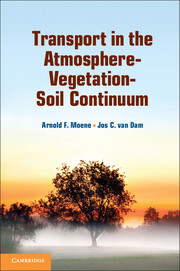Book contents
- Frontmatter
- Contents
- Preface
- 1 The Atmosphere-Vegetation-Soil System
- 2 Available Energy: Net Radiation and Soil Heat Flux
- 3 Turbulent Transport in the Atmospheric Surface Layer
- 4 Soil Water Flow
- 5 Solute Transport in Soil
- 6 Vegetation: Transport Processes Inside and Outside of Plants
- 7 Combination Methods for Turbulent Fluxes
- 8 Integrated Applications
- 9 Integrated Models in Hydrology and Meteorology
- Appendix A Radiation
- Appendix B Thermodynamics and Water Vapour
- Appendix C Dimensional Analysis
- Appendix D Microscopic Root Water Uptake
- Appendix E Crop Factors for Use with Makkink Reference Evapotranspiration
- Answers
- List of Main Symbols
- References
- Index
3 - Turbulent Transport in the Atmospheric Surface Layer
Published online by Cambridge University Press: 05 June 2014
- Frontmatter
- Contents
- Preface
- 1 The Atmosphere-Vegetation-Soil System
- 2 Available Energy: Net Radiation and Soil Heat Flux
- 3 Turbulent Transport in the Atmospheric Surface Layer
- 4 Soil Water Flow
- 5 Solute Transport in Soil
- 6 Vegetation: Transport Processes Inside and Outside of Plants
- 7 Combination Methods for Turbulent Fluxes
- 8 Integrated Applications
- 9 Integrated Models in Hydrology and Meteorology
- Appendix A Radiation
- Appendix B Thermodynamics and Water Vapour
- Appendix C Dimensional Analysis
- Appendix D Microscopic Root Water Uptake
- Appendix E Crop Factors for Use with Makkink Reference Evapotranspiration
- Answers
- List of Main Symbols
- References
- Index
Summary
Introduction
This chapter is concerned with exchange processes between the surface and the atmosphere. According to the surface energy balance, during daytime the net input of energy at Earth’s surface (Q* – G) is used to supply heat to the atmosphere and to evaporate water. This heat and water vapour needs to be transported away from the surface. During night time, on the other hand, as we have seen in Chapter 2, the available energy is generally negative and hence the sensible heat is transported downward (water vapour can go either way). The exact partitioning between the sensible and latent heat flux (both during day time and night time) is at this stage not crucial and is dealt with later in Chapter 7.
How does this transport of heat and water vapour from and to the surface occur? If we take heat transport as an example, one option could be to transport the heat by molecular heat diffusion. A typical daytime value for the sensible heat flux could be 100 W m–2, and the thermal diffusivity of air is around 2·10–5 m2 s–1. Then we can derive from Eq. (1.6) that a vertical temperature gradient of more than 4000 K per meter would be required (note that in this case the transported quantity used in Eq. (1.6) is enthalpy per unit volume: ρcpT). It is clear that vertical temperature gradients of this magnitude do not occur, so there must be another mode of transport. This is turbulent transport: heat, water vapour (and other gases) as well as momentum are transported by the movement of parcels of air that carry different concentrations of heat, water vapour, etc.
- Type
- Chapter
- Information
- Transport in the Atmosphere-Vegetation-Soil Continuum , pp. 69 - 132Publisher: Cambridge University PressPrint publication year: 2014



